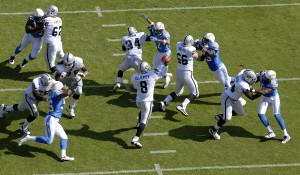Roger Goodell believes the NFL’s new player safety rules are working.
 Goodell participated in a series of meetings on player health and safety at the league’s headquarters Wednesday. He said the feedback he has received from coaches, players, officials and administrators has been positive.
Goodell participated in a series of meetings on player health and safety at the league’s headquarters Wednesday. He said the feedback he has received from coaches, players, officials and administrators has been positive.
“The overwhelming reaction is that players are adjusting to the new rules, the new techniques,” Goodell said. “I do believe that this is a very positive shift in the culture. You’re always going to have things that don’t necessarily fit into that culture in a period of time, but people are recognizing when these hits don’t fit into the context of the game.”
Asked about appeals officer Matt Birk overturning the one-game suspension for Tampa Bay safety Dashon Goldson for a helmet-to-helmet hit on New Orleans running back Darren Sproles, Goodell said he had not read the decision. But he stressed that the $100,000 fine delivers a message to Goldson and others that such hits must be eliminated from football.
“It’s not that there wasn’t a violation of the rule, and it’s not that there were not consequences for violating the rule,” he said. “So that, in and of itself, is a shift, and a positive shift that the culture is changing. But the culture doesn’t change overnight, and we will probably always have violations of rules.”
The Buccaneers could wind up being punished financially for excessive fines accumulated by their players this season. In fact, any team is subject to such penalties.
Fine amounts under the league’s club remittance policy for player safety count toward a team maximum of $105,000. If a team’s players go over that, the club is fined $50,000. If the total of fines gets to $157,500, the club must hand over another $25,000 and match any subsequent fines or suspension amounts. The most an individual’s fine can count toward the club total is $50,000, and Goldson already has two infractions worth $80,000 in fines.
Tampa Bay is at $87,825 in 2013 – just two games into the season.
Goodell also said the league has compromised as much as it can with the players’ union on HGH testing. The NFL and NFLPA agreed in principle to conducting such tests in the 2011 collective bargaining agreement, but the union has balked about procedural matters in the testing, and about the appeals process, for which the union wants neutral arbitration. Both sides have gotten much closer to finding a solution, but no testing is happening yet.
“What does neutral arbitration add but more credibility?” NFLPA executive director DeMaurice Smith said. “The majority of the policy that they already agreed to allows the commissioner to impose discipline, but an appeal is subject to neutral arbitration if the player so chooses. The players don’t want an exception to the rule.”
The NFL will release its second annual health and player safety report next week. It will show that USA Football’s Heads Up Football program to teach the proper and safest tackling techniques has met with an overwhelmingly popular response. The NFL, which supports USA Football and the program, expected perhaps 100 youth football organizations to sign up this year; 2,800 have, covering more than 90,000 coaches and 600,000 players.
“Next year, we’re going to look to get to all 10,000 across the country,” said Jeff Miller, the league’s senior vice president of health and safety. “We want youth football unified in a way that it’s taught safer and better.”
Was this article valuable?
Here are more articles you may enjoy.


 Waymo to Update Software Across Fleet After Major Power Failure
Waymo to Update Software Across Fleet After Major Power Failure  Twice Injured Firefighter Loses Second Workers’ Compensation Claim
Twice Injured Firefighter Loses Second Workers’ Compensation Claim  Tesla Drivers Are Buying Escape Tools and Cars to Avoid Getting Trapped Inside
Tesla Drivers Are Buying Escape Tools and Cars to Avoid Getting Trapped Inside  Apollo Expands Asset-Level Risk Reviews to Reflect Impact of Extreme Weather
Apollo Expands Asset-Level Risk Reviews to Reflect Impact of Extreme Weather 